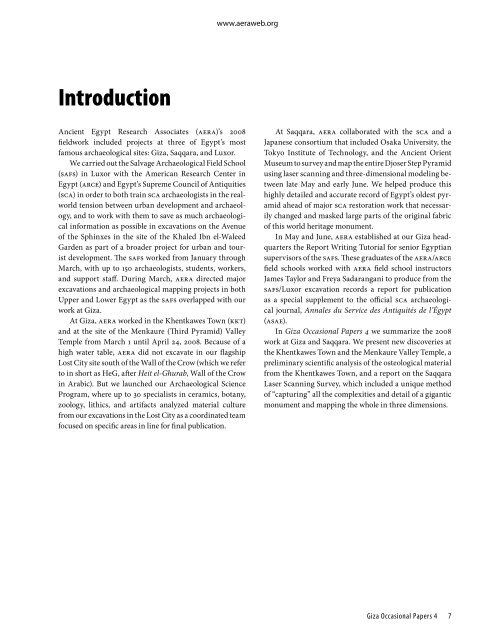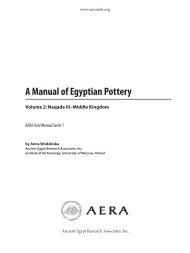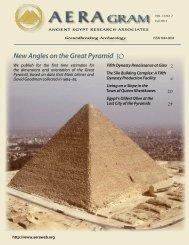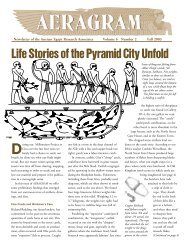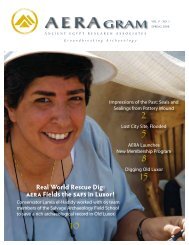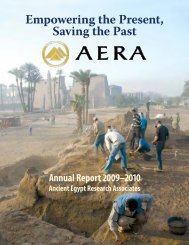The Khentkawes Town (KKT) - Ancient Egypt Research Associates
The Khentkawes Town (KKT) - Ancient Egypt Research Associates
The Khentkawes Town (KKT) - Ancient Egypt Research Associates
Create successful ePaper yourself
Turn your PDF publications into a flip-book with our unique Google optimized e-Paper software.
www.aeraweb.org<br />
Introduction<br />
<strong>Ancient</strong> <strong>Egypt</strong> <strong>Research</strong> <strong>Associates</strong> (AERA)’s 2008<br />
fieldwork included projects at three of <strong>Egypt</strong>’s most<br />
famous archaeological sites: Giza, Saqqara, and Luxor.<br />
We carried out the Salvage Archaeological Field School<br />
(SAFS) in Luxor with the American <strong>Research</strong> Center in<br />
<strong>Egypt</strong> (ARCE) and <strong>Egypt</strong>’s Supreme Council of Antiquities<br />
(SCA) in order to both train SCA archaeologists in the realworld<br />
tension between urban development and archaeology,<br />
and to work with them to save as much archaeological<br />
information as possible in excavations on the Avenue<br />
of the Sphinxes in the site of the Khaled Ibn el-Waleed<br />
Garden as part of a broader project for urban and tourist<br />
development. <strong>The</strong> SAFS worked from January through<br />
March, with up to 150 archaeologists, students, workers,<br />
and support staff. During March, AERA directed major<br />
excavations and archaeological mapping projects in both<br />
Upper and Lower <strong>Egypt</strong> as the SAFS overlapped with our<br />
work at Giza.<br />
At Giza, AERA worked in the <strong>Khentkawes</strong> <strong>Town</strong> (<strong>KKT</strong>)<br />
and at the site of the Menkaure (Third Pyramid) Valley<br />
Temple from March 1 until April 24, 2008. Because of a<br />
high water table, AERA did not excavate in our flagship<br />
Lost City site south of the Wall of the Crow (which we refer<br />
to in short as HeG, after Heit el-Ghurab, Wall of the Crow<br />
in Arabic). But we launched our Archaeological Science<br />
Program, where up to 30 specialists in ceramics, botany,<br />
zoology, lithics, and artifacts analyzed material culture<br />
from our excavations in the Lost City as a coordinated team<br />
focused on specific areas in line for final publication.<br />
At Saqqara, AERA collaborated with the SCA and a<br />
Japanese consortium that included Osaka University, the<br />
Tokyo Institute of Technology, and the <strong>Ancient</strong> Orient<br />
Museum to survey and map the entire Djoser Step Pyramid<br />
using laser scanning and three-dimensional modeling between<br />
late May and early June. We helped produce this<br />
highly detailed and accurate record of <strong>Egypt</strong>’s oldest pyramid<br />
ahead of major SCA restoration work that necessarily<br />
changed and masked large parts of the original fabric<br />
of this world heritage monument.<br />
In May and June, AERA established at our Giza headquarters<br />
the Report Writing Tutorial for senior <strong>Egypt</strong>ian<br />
supervisors of the SAFS. <strong>The</strong>se graduates of the AERA/ARCE<br />
field schools worked with AERA field school instructors<br />
James Taylor and Freya Sadarangani to produce from the<br />
SAFS/Luxor excavation records a report for publication<br />
as a special supplement to the official SCA archaeological<br />
journal, Annales du Service des Antiquités de l’Égypt<br />
(ASAE).<br />
In Giza Occasional Papers 4 we summarize the 2008<br />
work at Giza and Saqqara. We present new discoveries at<br />
the <strong>Khentkawes</strong> <strong>Town</strong> and the Menkaure Valley Temple, a<br />
preliminary scientific analysis of the osteological material<br />
from the <strong>Khentkawes</strong> <strong>Town</strong>, and a report on the Saqqara<br />
Laser Scanning Survey, which included a unique method<br />
of “capturing” all the complexities and detail of a gigantic<br />
monument and mapping the whole in three dimensions.<br />
Giza Occasional Papers 4 7


